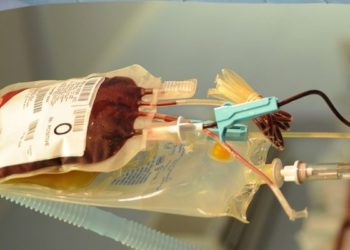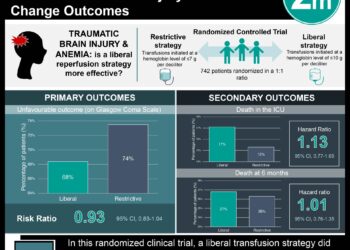Elderly anemic patients at higher risk of postoperative mortality after vascular procedures
Image: PD
1. Elderly anemic patients were found to have both an increased rate of mortality and cardiac events after elective open and endovascular procedures.
2. For every percentage point decrease in hematocrit from baseline, there was a 4.2% increase in the adjusted risk of 30-day postoperative mortality.
Evidence Rating Level: 2 (Good)
Study Rundown: In order to address peripheral arterial disease, elderly patients often elect to undergo endovascular procedures. While anemia has been associated with adverse outcomes in cardiac surgery, its role in complications of vascular surgery has not been examined. The authors set out to explore the role of anemia in vascular surgery in a large, multicenter prospective study. They found that like in cardiac surgery, anemia was an independent risk factor for postoperative complications and mortality in vascular surgery. This is a crucial finding as it suggests that preoperative hemoglobin optimization should be pursued at least as aggressively in vascular cases as it is in cardiac ones. Additionally, as the authors suggest, early detection of anemia prior to surgery is clearly indicated. One of this study’s main strengths was its size and scope – over 250 databases and close to 32,000 patients were included in their analyses.
Click to read the study in the Annals of Surgery
Click to read an accompanying editorial in Anesthesia and Analgesia
Relevant Reading: Detection, evaluation, and management of anemia in the elective surgical patient
In-Depth [prospective cohort study]: This study used data from NSQIP Participant Use Data Files which draws from a wide variety of academic and community hospitals in the US (n = 31,857). The primary outcomes studied were 30-day postoperative mortality and postoperative cardiac events (arrest or myocardial infarction). From the entire data set, 47.9% of patients were found to have preoperative anemia. Elderly anemic patients, when compared to patients with normal hematocrit levels, were at an increased risk of mortality. Anemic patients had a mortality rate of 2.4% compared to 1.2% in those patients with normal hematocrit levels (p > .0001). The cardiac event rate was 2.3% in the anemic patients and only 1.2% in the non-anemic patients (p > .0001). These results suggest that careful inspection of hematocrit prior to vascular surgery is prudent.
By Amir Tarsha and Chaz Carrier
More from this author: Local excision inferior to major resection in T1-2 colon cancer and T2 rectal cancer, Secondary mastoid obliteration improves quality of life for patients with chronic otitis media, Healthcare reform linked with reduced racial disparities in surgical care, VATS lobectomy may be preferred in COPD with non-small-cell lung cancer, One-on-one training leads to improved virtual reality laparoscopic performance
©2012-2013 2minutemedicine.com. All rights reserved. No works may be reproduced without expressed written consent from 2minutemedicine.com. Disclaimer: We present factual information directly from peer reviewed medical journals. No post should be construed as medical advice and is not intended as such by the authors, editors, staff or by 2minutemedicine.com. PLEASE SEE A HEALTHCARE PROVIDER IN YOUR AREA IF YOU SEEK MEDICAL ADVICE OF ANY SORT.






